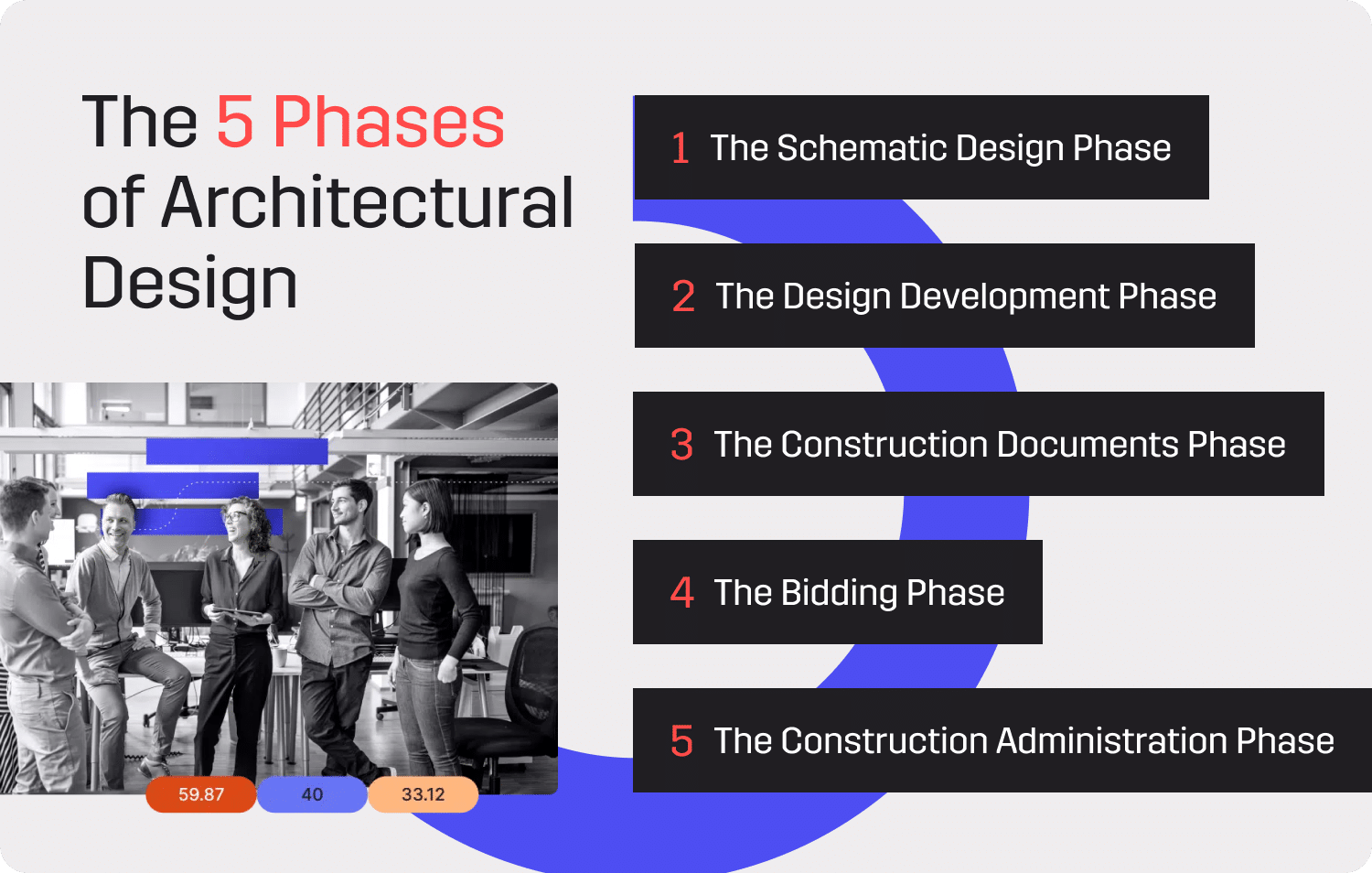Bringing a vision to life—whether it’s designing a home or planning a business space—requires careful planning and execution. To simplify and organize their work, architects follow a structured framework known as the architectural design phases.
In this article, we’ll take a closer look at each of these five phases, breaking them down step by step, and share practical tips to help you navigate the process with confidence.
What are the Architectural Design Phases?
The architectural design phases represent a structured roadmap architects follow to transform an initial idea into a completed structure. These five phases ensure that creativity, practicality, and technical requirements are balanced at every step. Each phase serves a distinct purpose, building upon the previous one to ensure a seamless transition from concept to construction.
Why They Matter: These phases not only streamline the workflow but also enhance communication among stakeholders, ensuring that everyone is aligned and working toward a common vision.
Who’s Involved: From architects to engineers, consultants, contractors, and clients, each phase involves collaboration across disciplines.
The 5 Stages of Architectural Design
1. Schematic Design
The schematic design phase is where ideas begin to take shape. During this stage, architects collaborate with clients to explore concepts and develop preliminary designs.
Start with a Feasibility Study: Before entering schematic design, it’s crucial to conduct a feasibility study to evaluate the project’s viability. A feasibility study assesses factors like site conditions, budget constraints, and regulatory requirements, ensuring that the design concept aligns with practical realities.
Key Steps of the Schematic Design Phase
• Conducting initial site analysis to identify constraints and opportunities.
• Sketching layouts, floor plans, and spatial arrangements.
• Exploring various design options and creative directions.
• Creating basic 3D renderings and diagrams to help clients visualize the project.
Deliverables: Preliminary designs, including conceptual layouts and basic renderings.
Client Role: Provide feedback on designs to refine the direction before moving forward.
Importance: Establishes the project’s scope, functionality, and aesthetic direction, setting the stage for more detailed design work.
2. Design Development
The design development phase takes the concepts from the schematic stage and refines them into more detailed plans.
Key Steps of the Design Development Phase
• Selecting materials, finishes, and systems to align with design intent and budget.
• Refining layouts, dimensions, and structural details.
• Collaborating with consultants such as structural, mechanical, and electrical engineers.
Deliverables: Detailed drawings, material specifications, and cost estimates.
Client Role: Approve material and design selections while ensuring the project stays within budget.
Importance: Bridges the gap between concept and technical execution, ensuring that the design is feasible and aligned with client expectations.
3. Construction Documents
In the construction documents phase, architects prepare comprehensive blueprints and specifications for the project.
Key Steps of the Construction Documents Phase
• Developing technical drawings for contractors that detail every aspect of the construction process.
• Creating schedules for materials, finishes, and equipment.
• Ensuring compliance with building codes, zoning regulations, and safety standards.
Deliverables: A complete set of construction documents, including detailed plans, elevations, sections, and specifications.
Client Role: Review and approve final documents before they are issued to contractors.
Importance: Provides contractors with the necessary information to construct the project accurately and efficiently.
4. Bidding
The bidding phase is where contractors compete to bring the design to life.
Key Steps of the Bidding Phase
• Issuing construction documents to potential contractors and inviting bids.
• Evaluating bids and conducting interviews with contractors.
• Assisting clients in comparing proposals and selecting the best contractor.
Deliverables: A signed construction agreement with a qualified contractor.
Client Role: Make the final decision on contractor selection with guidance from the architect.
Importance: Ensures the project is built by a trusted contractor at a competitive price.
5. Construction Administration
The construction administration phase ensures the design intent is realized during the building process.
Key Steps of the Construction Administration Phase
• Conducting regular site visits to monitor progress and address issues.
• Reviewing submittals, shop drawings, and material samples for compliance with design specifications.
• Addressing design clarifications and resolving construction challenges.
Deliverables: Progress reports, approved submittals, and a completed project.
Client Role: Stay engaged in the process and provide timely approvals when needed.
Importance: Ensures the final structure aligns with the original vision and quality standards.

Why Mastering the Phases of Architectural Design Matters
Mastering the architectural design phases is key to turning creative visions into reality with precision and purpose. This structured approach ensures every element—from concept to construction—works in harmony, balancing aesthetics, functionality, and technical requirements.
By understanding and excelling in these five stages, architects can:
Deliver Outstanding Results: Consistently meet or exceed client expectations by aligning designs with their vision, budget, and timeline.
Reduce Risk and Rework: Proactively address potential issues early, avoiding costly redesigns, construction delays, and miscommunications.
Design with Purpose: Combine beauty and functionality to create structures that serve immediate needs while standing the test of time.
Strengthen Team Collaboration: Foster clear communication and alignment among all stakeholders, including architects, engineers, contractors, and clients, ensuring seamless teamwork.
When architects master these phases, they not only streamline their processes but also elevate the quality and impact of their work, setting the stage for long-lasting success.
How Project Management Software Supports the Architectural Phases
Managing the phases of design architecture can be complex, but project management software can simplify the process. Here’s how:
Centralized Communication: Keep all stakeholders aligned by housing updates, documents, and discussions in one place.
Resource Management: Track budgets, timelines, and team responsibilities across the architecture project stages.
Real-Time Collaboration: Share progress and get feedback instantly, reducing delays.
Document Control: Ensure all versions of plans and specifications are up-to-date and accessible.
With tools like Total Synergy, architects can streamline workflows, improve communication, and stay focused on creative design. By integrating project management software into your workflow, you can ensure every phase of the process runs smoothly.
Summary: What are the Architectural Design Phases?
The architectural design process is a journey from vision to reality, guided by five structured phases: schematic design, design development, construction documents, bidding, and construction administration. Each phase plays a crucial role, from conceptualizing ideas and refining designs to preparing detailed plans and overseeing construction. Architects, clients, and consultants collaborate at every stage, ensuring the project is both creative and practical. Using project management software like Total Synergy can streamline workflows, improve collaboration, and ensure projects stay on track from start to finish.
Frequently Asked Questions About the Architectural Design Phases
What are the five phases of architectural design?
The five phases of architectural design are schematic design, design development, construction documents, bidding, and construction administration. Each phase plays a unique role in transforming an idea into a completed structure, from initial concept creation to overseeing the construction process.
What happens during the schematic design phase?
During the schematic design phase, architects collaborate with clients to develop initial concepts and layouts. This phase includes site analysis, sketching plans, exploring creative directions, and creating basic 3D renderings to visualize the project.
Why is the design development phase important?
The design development phase refines the initial concepts into detailed plans, selecting materials, finalizing layouts, and incorporating technical details. It bridges the gap between creativity and technical execution, ensuring feasibility and alignment with the client’s vision.
What is the role of architects during the construction administration phase?
In the construction administration phase, architects ensure the project aligns with the original design intent. They conduct site visits, review materials and progress, address construction challenges, and act as a liaison between clients and contractors.
How can project management software help with architectural design phases?
Project management software like Total Synergy streamlines workflows, improves collaboration, and keeps projects on track. It centralizes communication, tracks resources, and ensures all stakeholders are aligned throughout the architectural design phases.





